
Based on the SF90 Stradale, the new special limited series SF90 XX Stradale was unveiled today alongside its SF90 XX Spider counterpart. To be built in just 799 and 599 examples respectively, these new V8-powered PHEVs represent the latest and most extreme example of a concept of special versions, which pushes the performance of Ferrari’s road-going models to new levels.
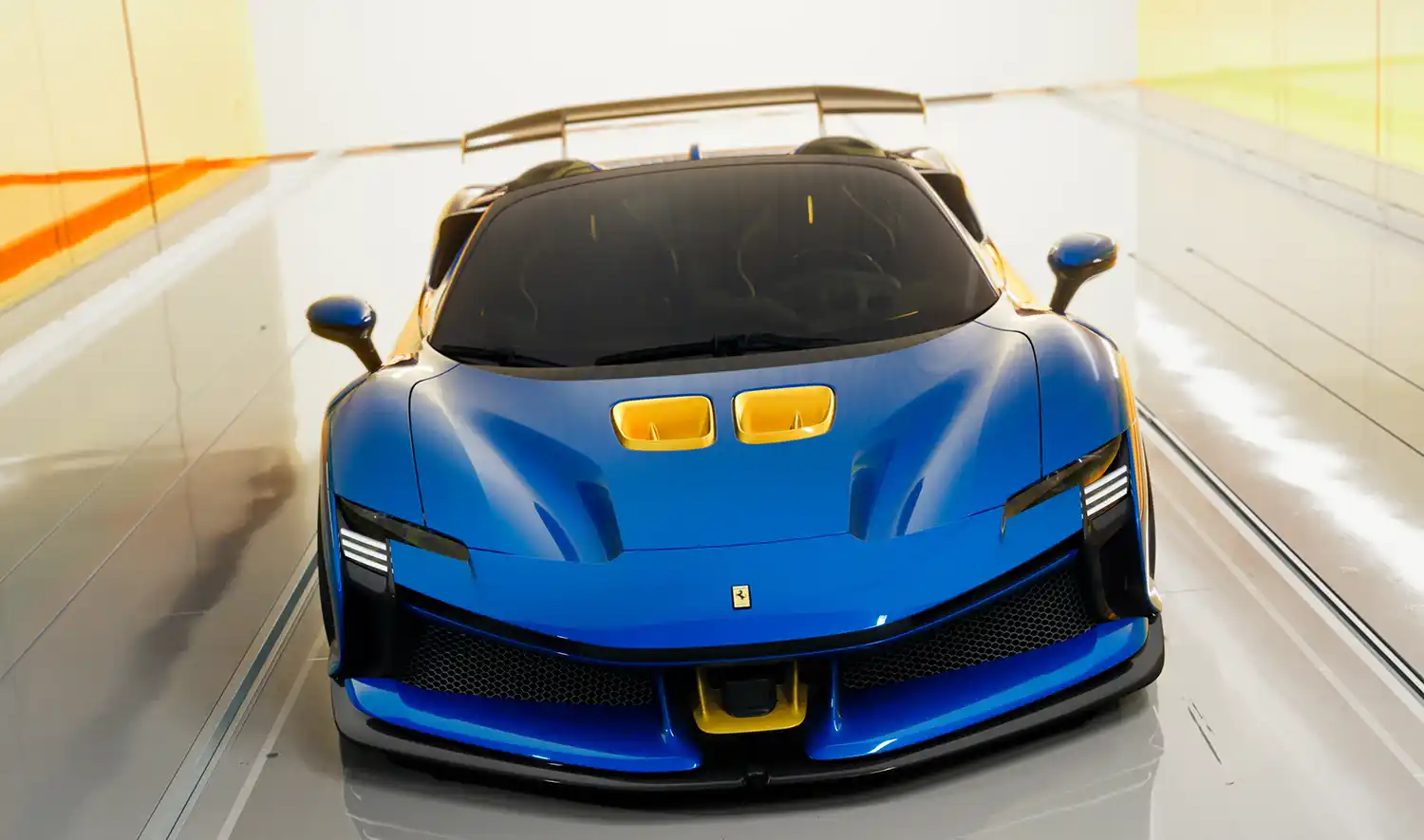
The concept has been honed over the past 20 years or so, with many of these models quickly becoming considered benchmarks in the Prancing Horse’s line up, such as the 488 Pista and 812 Competizione. Over the same two decades, Ferrari has also developed the XX Programme to offer a select group of expert client drivers extreme cars that are not homologated for the road, but that can be driven at the very limit on the track. All of the models produced by the programme have proved a huge success, with the most recent addition being the FXX-K EVO.
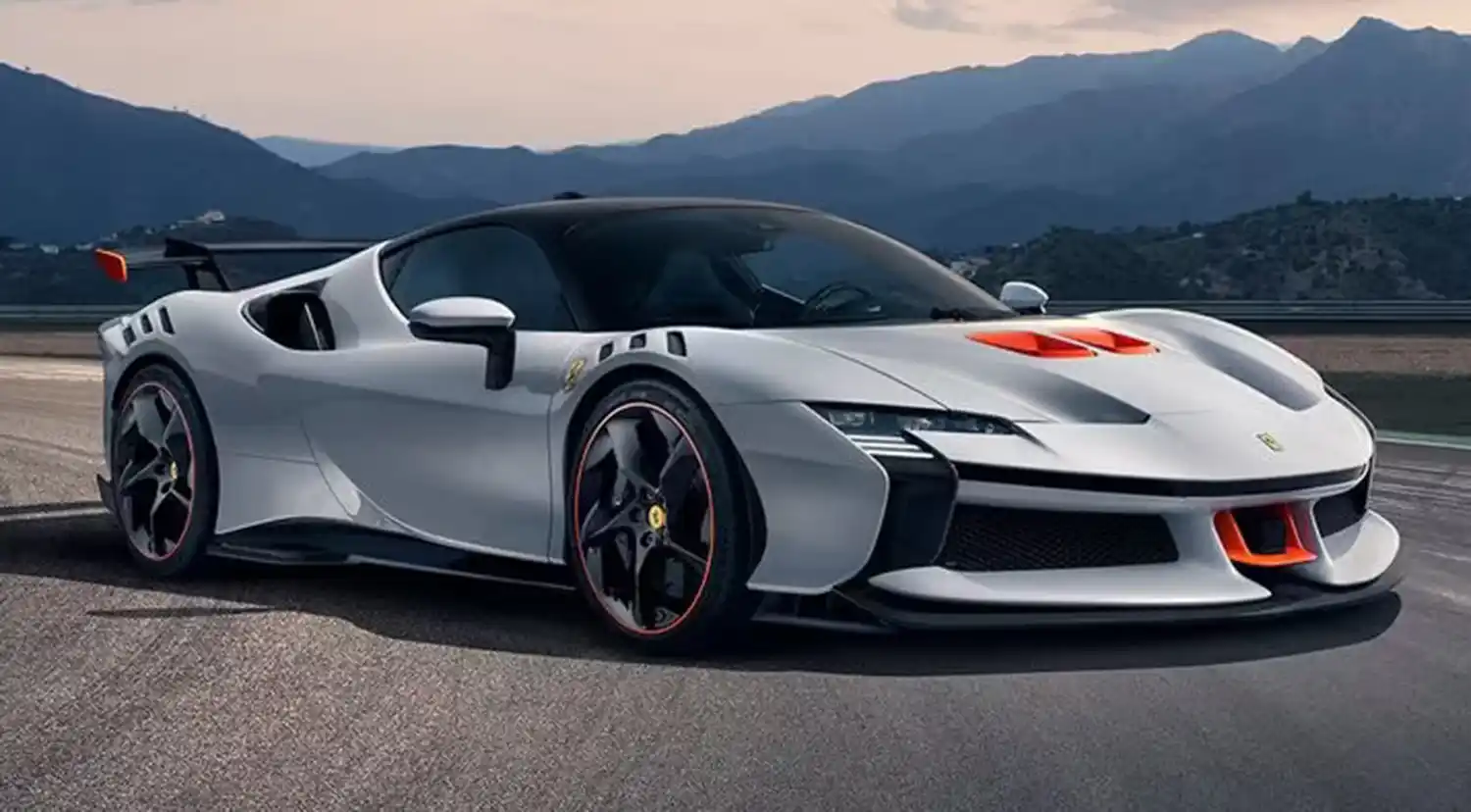
Drawing on its experience in both of these spheres, Ferrari decided to create a road-legal car which embodies the maximum expression of the two programmes’ engineering concepts. The SF90 XX Stradale is based on the supercar in the range, the SF90 Stradale, and raises its already impressively exhilarating track and on-the-limit driving experience to new s. Performance is boosted thanks to its impressive 1,030 cv (30 more than the SF90 Stradale), specific software logics and the use of radical new aerodynamics solutions, including a fixed rear spoiler – the first to appear on a road-going Ferrari since the days of the F50 – which delivers an unparalleled 530 kg of downforce at 250 km/h.

The same concept provided the inspiration for the SF90 XX Spider, which combines the ultimate on-track adrenaline rush with the heady pleasure of en plein air driving, where the iconic sound of the Ferrari V8 gives such a vital contribution. The SF90 XX Spider benefits from the same sophisticated aero solutions as the SF90 XX Stradale, as well as specifically developed cockpit air flows that guarantee superb occupant comfort with the top down. It is equipped with Ferrari’s acclaimed Retractable Hard Top (RHT), which comprises aluminium panels and not only deploys and retracts in a mere 14 seconds, but can also be activated at speeds of up to 45 km/h.
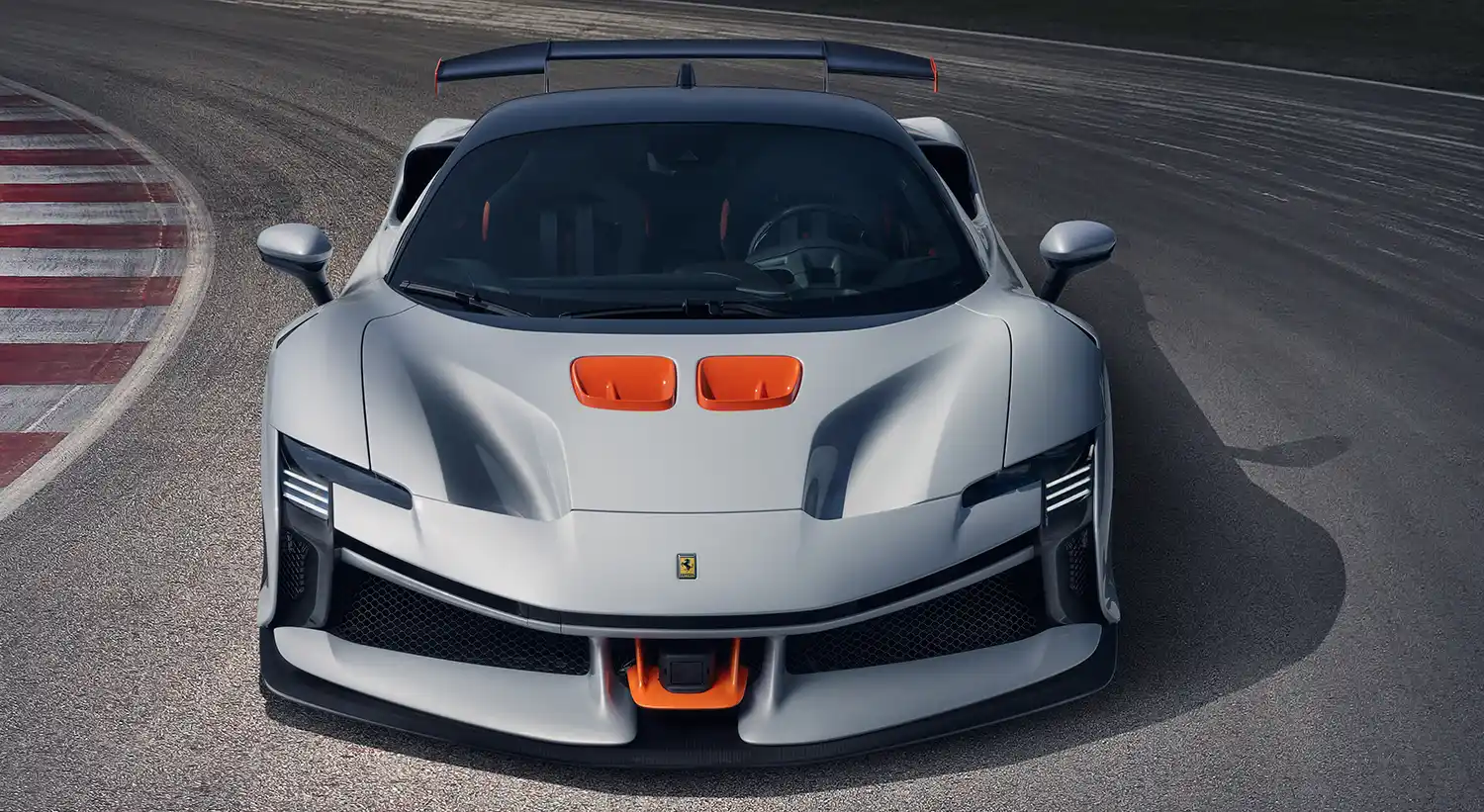
POWERTRAIN
The SF90 XX Stradale has also inherited the signature PHEV layout found in the SF90 Stradale and SF90 Spider, in which the V8 internal combustion engine is integrated with three electric motors, two independent on the front axle, and one located between the engine and gearbox at the rear. This configuration allows the car to unleash a maximum of 1030 cv (+30 cv more than the SF90 Stradale), setting a whole new performance benchmark.
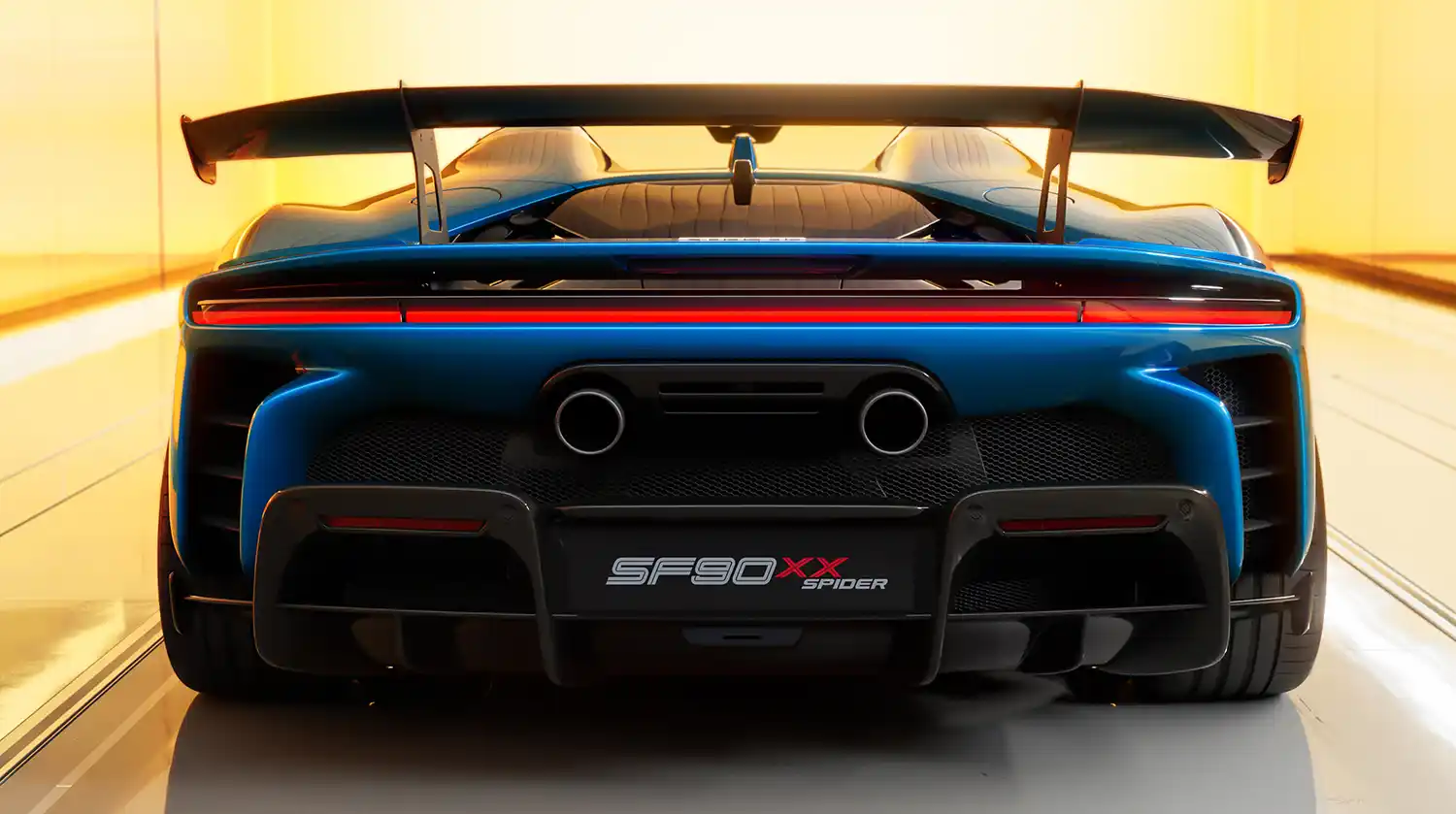
INTERNAL COMBUSTION ENGINE
Thanks to its 797 cv, the mid-rear-mounted V8 turbo raises the performance limit bar still further for this particular architecture. The SF90 Stradale’s power unit was used as the starting point for the F154FB engine which powers the SF90 XX Stradale, and is now significantly more extreme. Efficiency was increased by polishing the inlet and exhaust ducts and the compression ratio was increased with the adoption of new pistons and specific machining of the combustion chamber. The removal of the secondary air system also slashed 3.5 kg off the engine’s weight compared to the previous application.
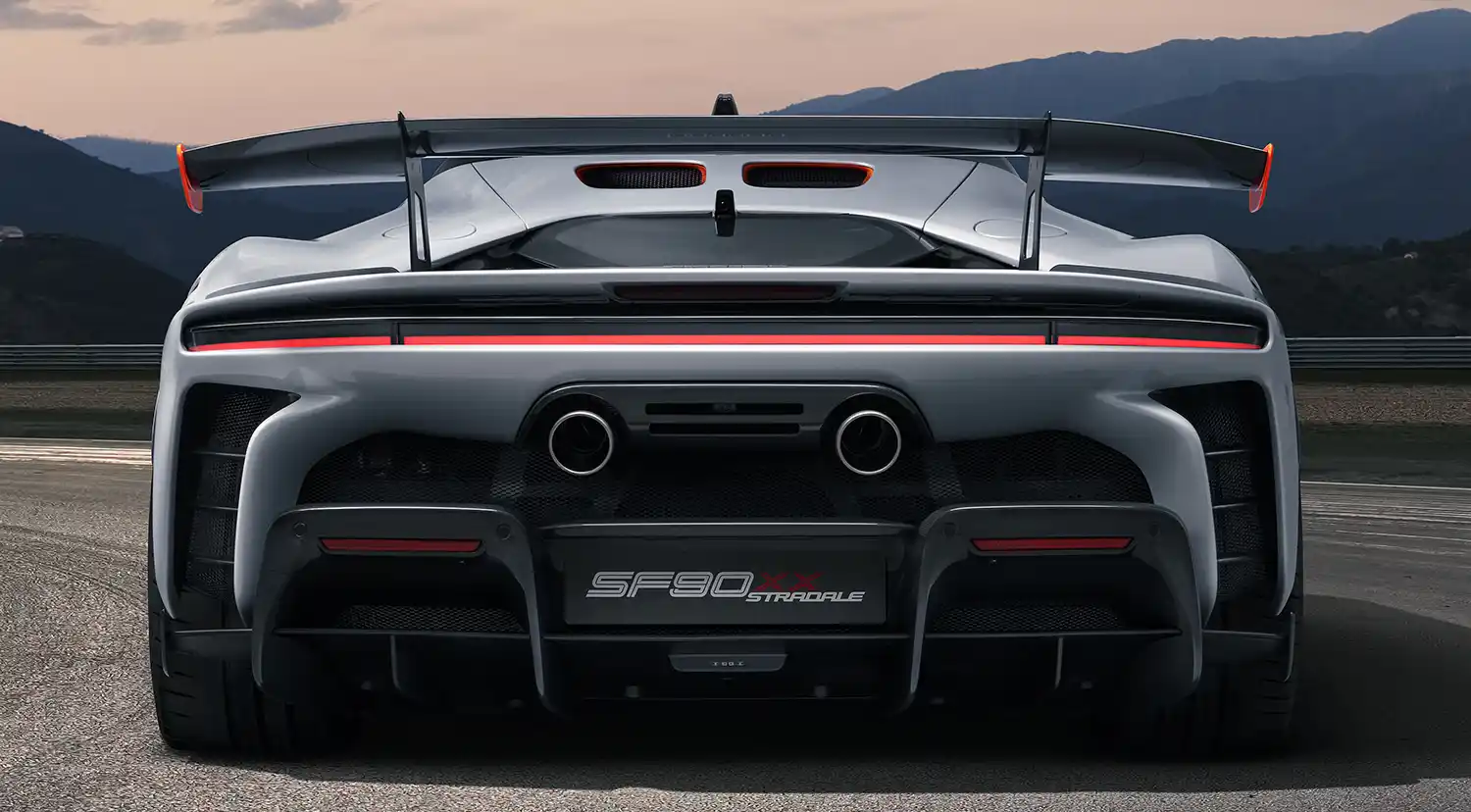
ENGINE SOUND
The SF90 XX Stradale’s soundtrack was redesigned to become the ultimate encapsulation of the car’s racing soul. To produce an even fuller, richer sound and celebrate the harmonics right across the V8’s rev range, the hot tube system was optimised. This transmits the combustion pulsations into the cabin, highlighting the higher frequencies to reveal the ultimate evolution of the Ferrari V8.
The use of innovative materials improved the acoustic clarity of the system: the result is a wonderfully rich explosion of iconic Ferrari V8 sound. The tube from the intake plenum has been redesigned and repositioned closer to the cabin’s bulkhead so that occupants are treated to even edgier, more raucous harmonics as the engine takes in greater quantities of air to deliver the desired torque. The resonator is now nearer the engine to create a richer harmony and increase intensity.
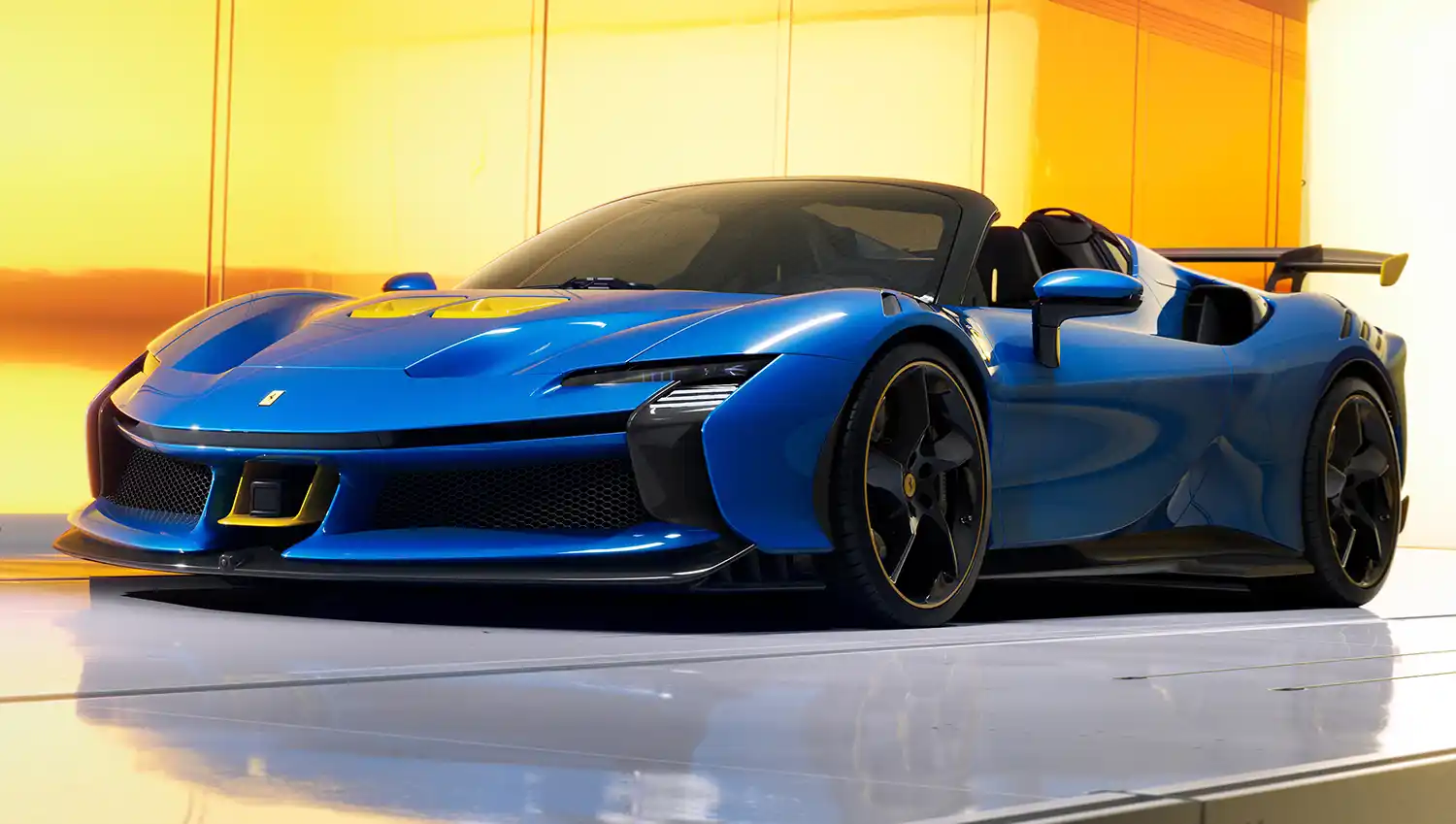
Work carried out on both branches of the hot tube system has produced a clear improvement in sound quality, which is at its finest at mid revs. However, as the car edges nearer to the limiter, the point at which the car unleashes the pinnacle of its power and might, the modifications ensure both quality and intensity continue to increase smoothly and progressively.
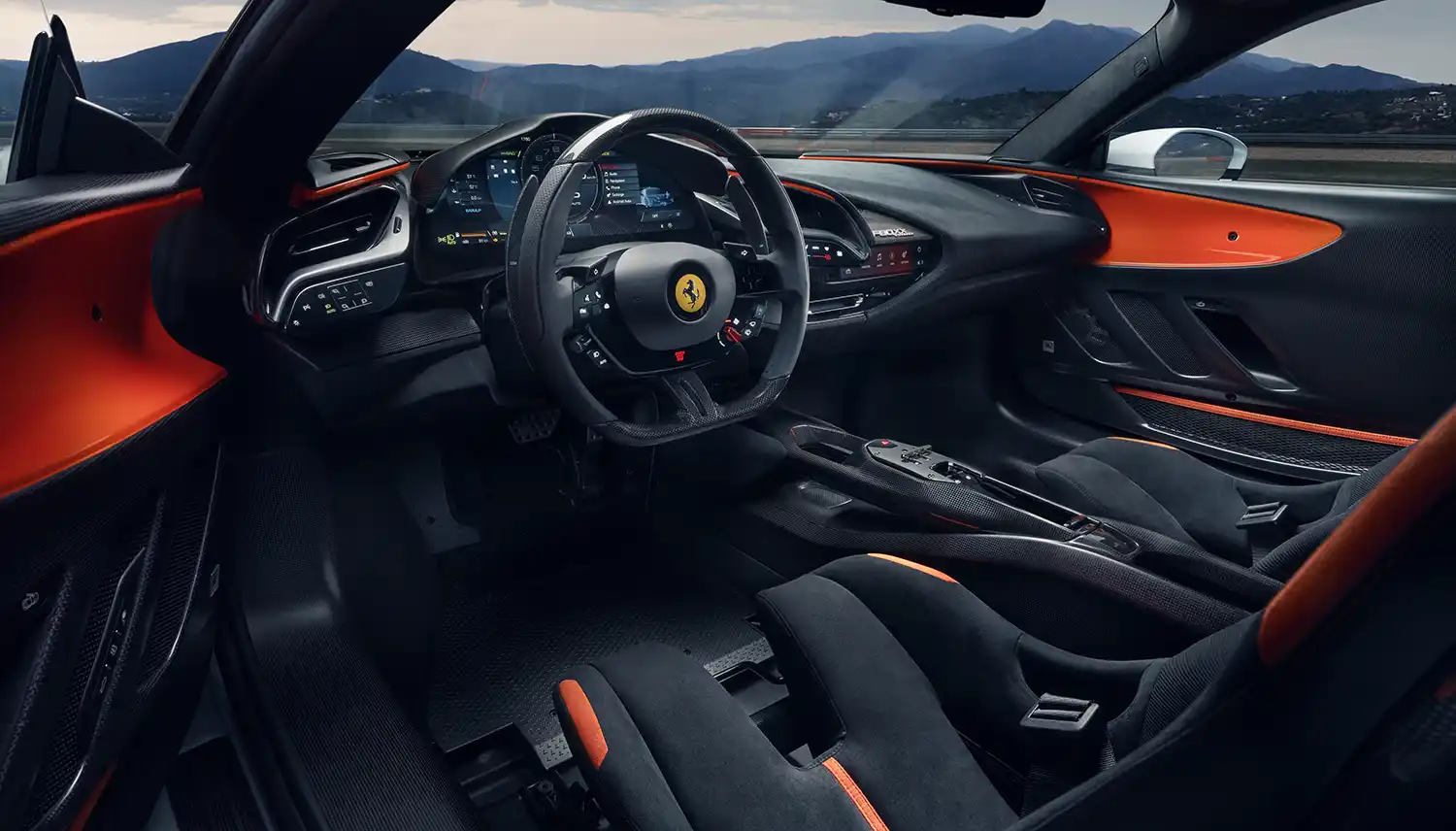
ELECTRIC MOTORS
Like the SF90 Stradale, the SF90 XX Stradale has three electric motors, one located between the ICE and the gearbox and two on the front axle. In this instance, they deliver a maximum of 233 cv or 171 kW, thanks to the patented extra boost vehicle dynamics logic, an absolute first on a Prancing Horse road car. The SF90 XX Stradale’s high performance lithium-ion battery powers the three motors, guaranteeing a 25km range in full-electric mode. When the ICE is off, the front motors give the car a maximum speed of 135 km/h.
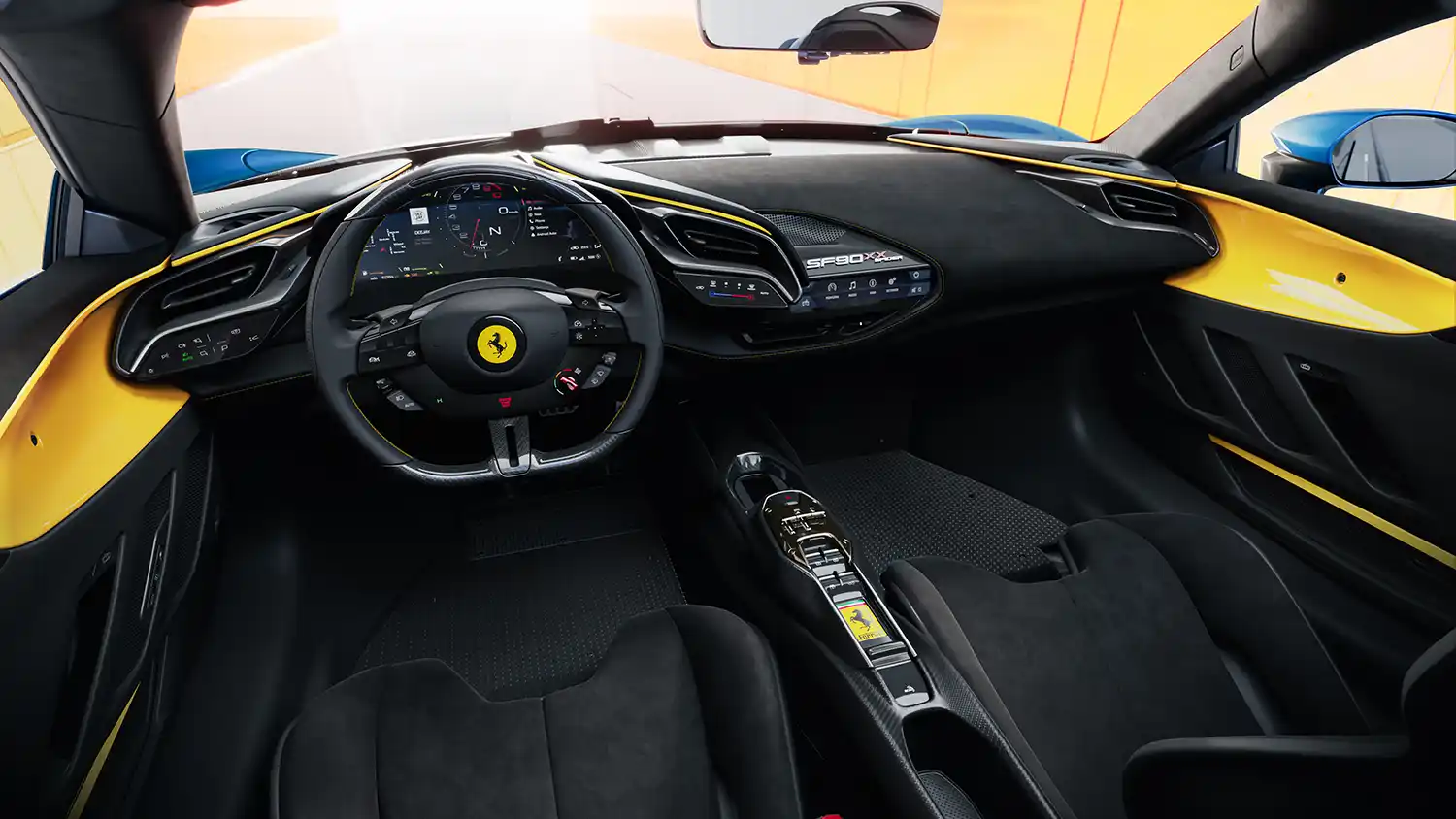
The control logic optimally manages the power flows focussing on either efficiency or performance as required. The driver can use the eManettino selector on the steering wheel to choose from four different power management modes. In eDrive mode, the internal combustion engine is turned off and traction is entrusted entirely to the front axle; in Hybrid mode, it favours battery energy depletion and manages transitions autonomously, maximising the full-electric range; in Performance mode, the internal combustion engine is kept running as the priority is on maintaining consistent performance, rather than on achieving the peak power; and in Qualifying, the system unleashes its maximum power output, thanks to a control logic that prioritises performance, using the brand-new extra boost function.
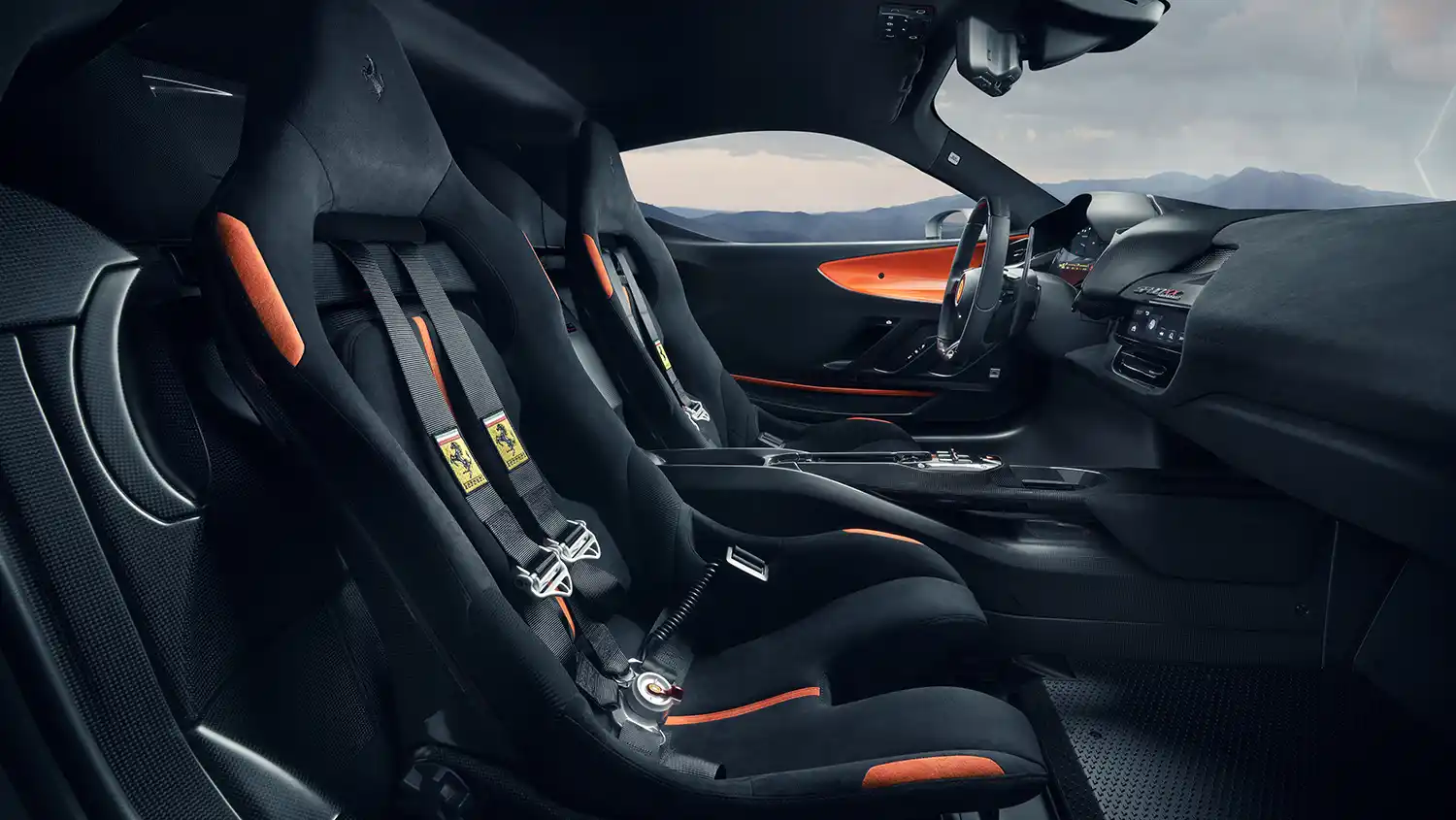
GEARBOX
The SF90 XX Stradale and the SF90 XX Spider retain the 8-speed dual-clutch gearbox that made its first appearance in the Ferrari range on the SF90 Stradale. However, the gear-shift logic has changed significantly: the car uses the patented logic introduced on the Ferrari Daytona SP3 to reach more engaging dynamic acceleration profiles. Furthermore, the new logic improves the gear-shift sound by introducing an exhaust note similar to the overrun on lift-off noise typical of high-performance driving at medium/high revs.
To that end, the Ferrari engineers developed a specific engine calibration that works in synergy with the gearbox control logic: the SF90 Stradale’s actuation sequence was redesigned and the combustion chamber pressure cycle was optimised to maximise the intensity of the gear-shift sound, at exactly the point of lift-off to allow the gearbox to engage.
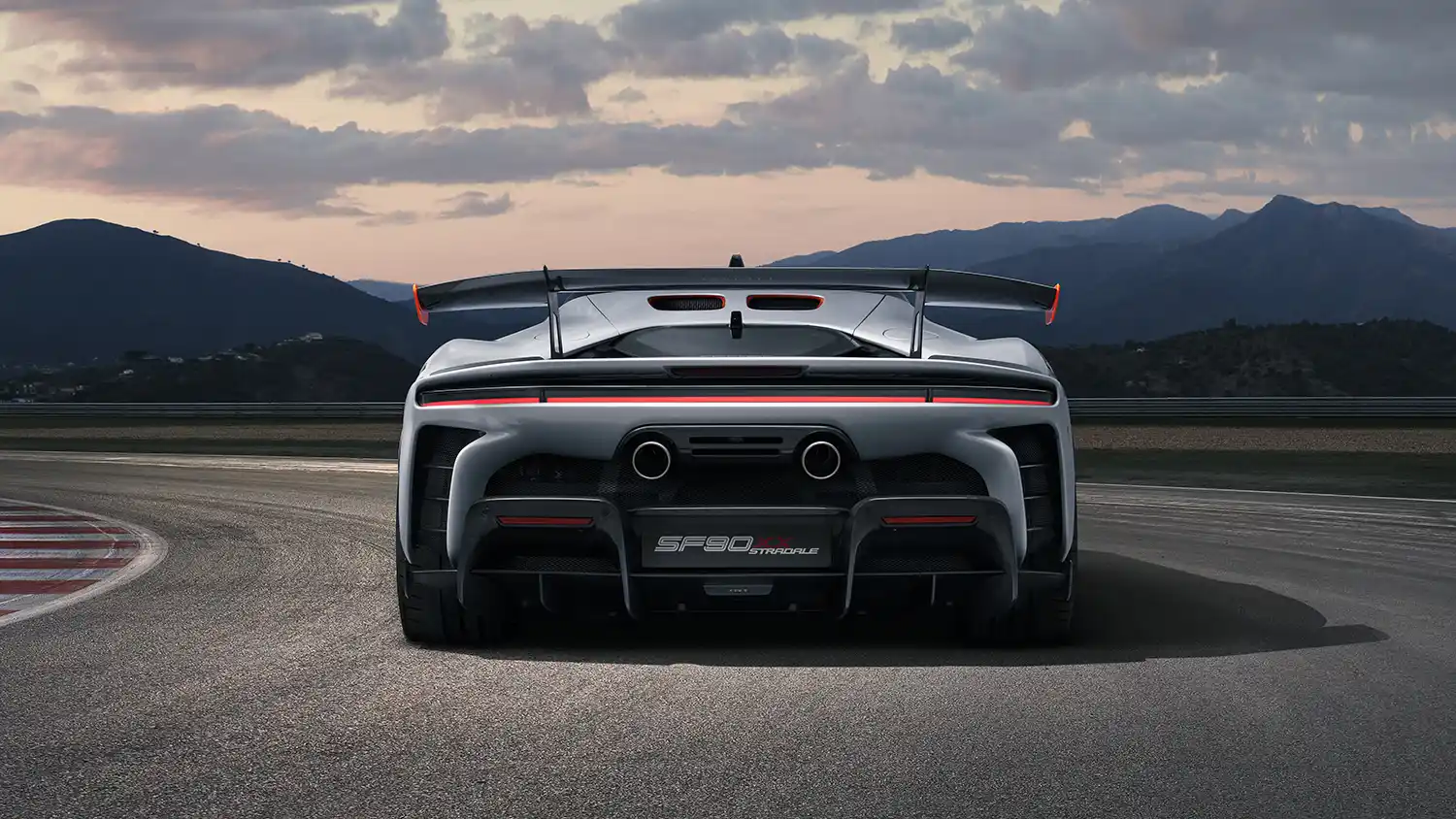
AERODYNAMICS
The SF90 XX Stradale delivers the most efficient aerodynamic performance of any road-going car in Ferrari’s history, making it comparable only to that of the LaFerrari supercar. It delivers double the maximum downforce of the SF90 Stradale, improving grip and yielding a palpably faster lap time at Fiorano. The product of Maranello’s inestimable racing experience, this result was reached by redesigning the cooling flow management for the thermal and electric components as well the engine compartment to cope with the higher maximum power available.
From an aerodynamics perspective, the signature element is most definitely the rear fixed wing which was developed from experience with the XX Programme cars. This is an element with enormous aero potential that proved a natural fit for this particular application, thanks to close collaboration with the Ferrari Styling Centre. Its shape was dictated by the need to efficiently hone the way in which the pressure field created by the wing interacts with the complex pressure and backpressure systems that develop around the shut-off Gurney.
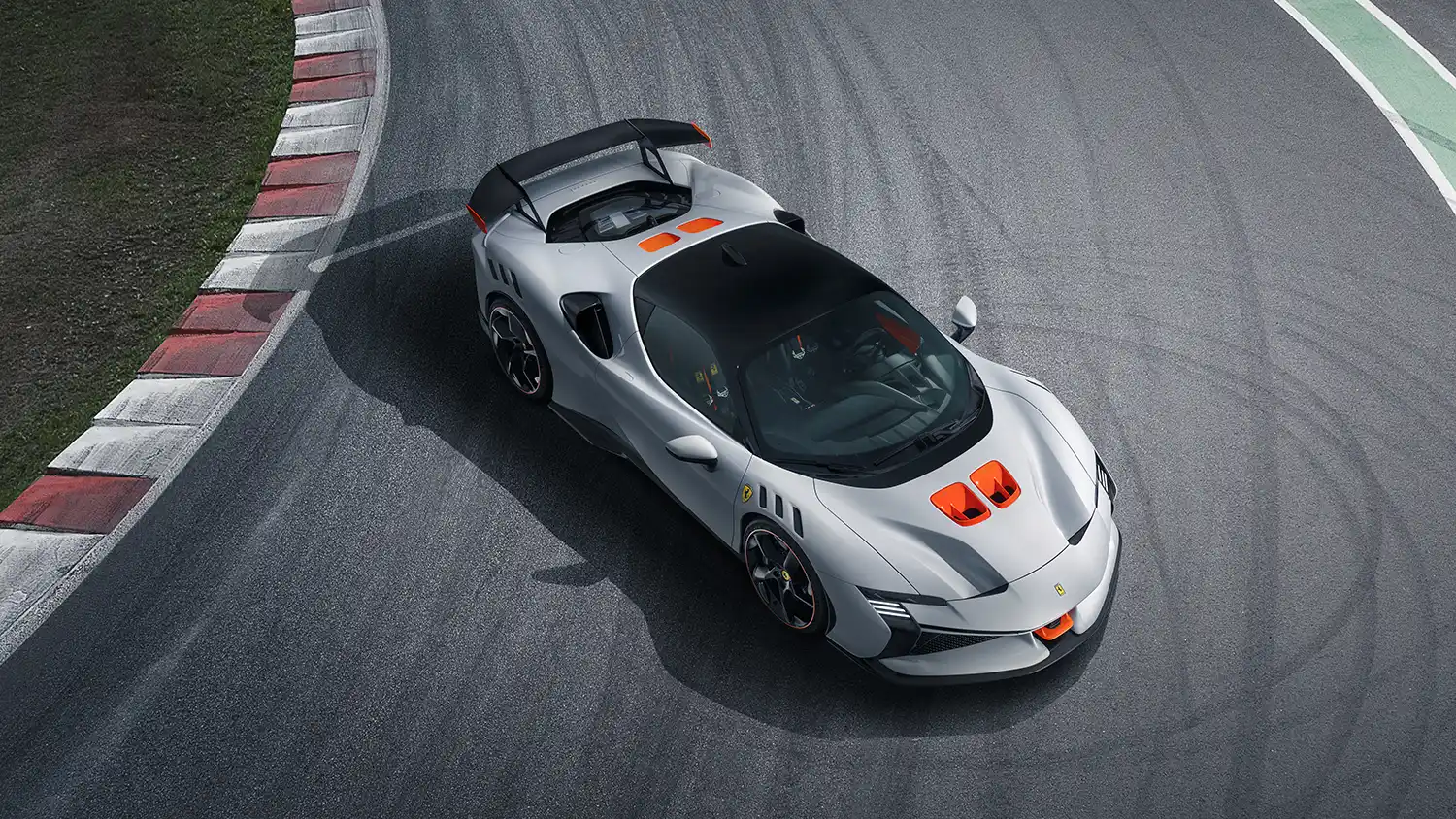
The latter, which was also redesigned, efficiently manages the downforce/drag trade-off and has two configurations: LD (Low Drag) in which the mobile element is raised and is faired in with the fixed section, minimising drag to enhance longitudinal performance, while in HD (High Downforce), the mobile element is lowered, closing the blown area, thereby allowing the air to hit the fixed area. This generates an overpressure area which, aside from generating rear downforce, also deflects the incoming flow vertically to help deliver the absolute maximum rear downforce possible: 315 kg at 250 km/h.
The ICE benefits from improved cooling thanks to the fact that the front radiators for the high temperature cooling circuit are more efficient. The new layout of the underbody was also optimised to guarantee improved extraction of the air coming off the radiators ahead of the front wheels. The side louvres on the lower part of the front bumper, already seen on the SF90 Stradale, were also redesigned and are now larger to reduce backpressure.
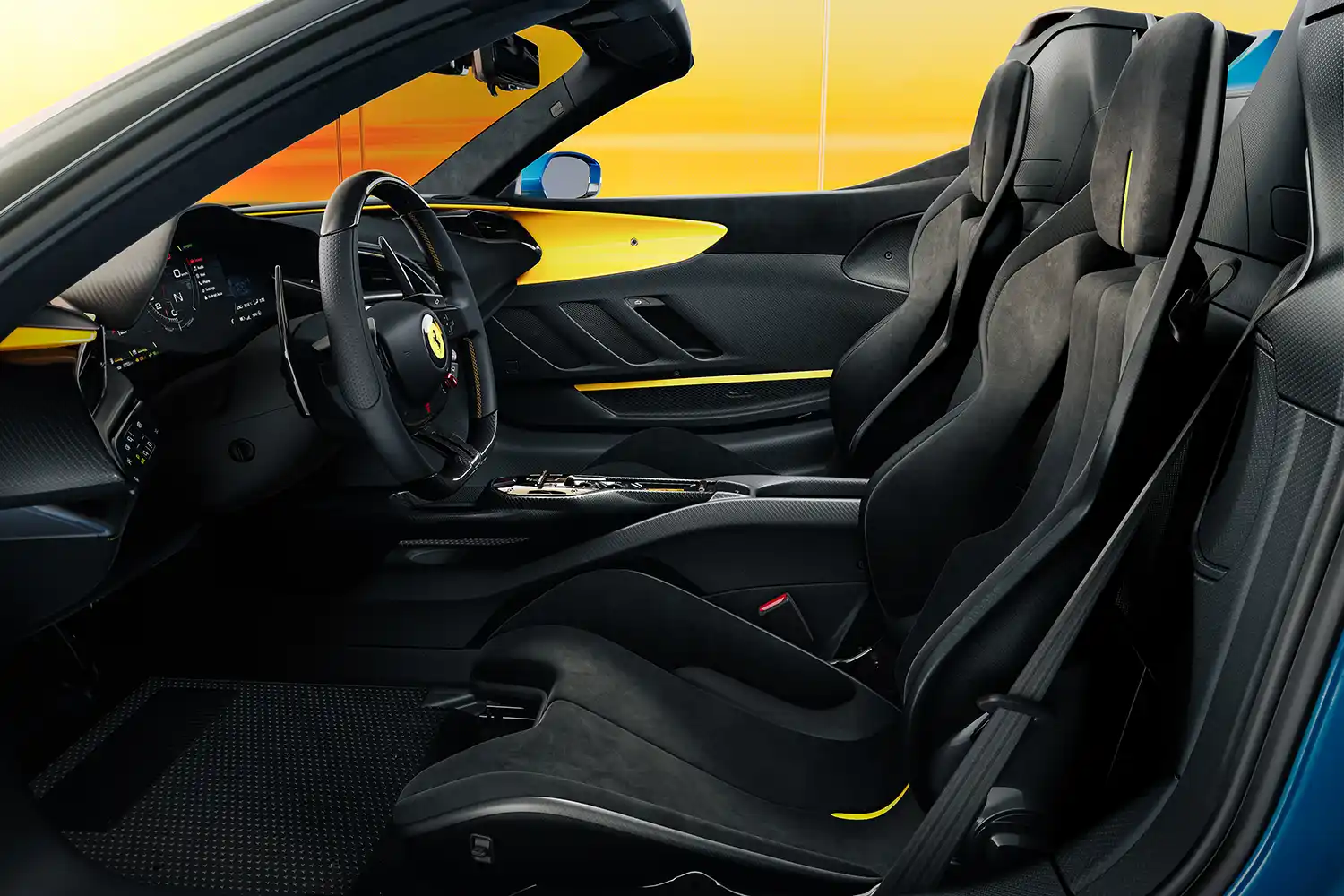
The simultaneous increase in power and downforce posed a new challenge which Ferrari’s engineers tackled by reversing the layout of the medium temperature radiator, tasked with cooling the electrical components, increasing its efficiency and also enclosing a part of the car’s underbody, thereby increasing the effective surfaces that would help generate front downforce. It should come as no surprise that this very clearly race-derived architecture is shared by the brand-new 296 GT3.
The different inclination of the front radiator improved the aerodynamic coefficients, simultaneously channelling hot air flows through and over the front bonnet. These flows are controlled and channelled over the car by two S-Ducts located one on either side of the vents in the centre of the bonnet.

At the rear of the car, a scoop in front of the entry to the intercooler air intake cleans and slows the expansion of the flow arriving at the radiators. When the car is moving, cool air is drawn into the engine compartment through three apertures: the first located above the intercooler intake on the side and the second crossways on the engine cover, while the third is a pair of ducts located to the sides of the struts of the fixed spoiler.
The car also has a specific front splitter, which is larger than the SF90 Stradale’s, and is the result of meticulous work in the wind tunnel. It generates a highly energised tube of air flow under the car and this is then exploited by the redesigned underbody. A larger, wider front diffuser contributes to the increase in downforce of over 45 kg at 250 km/h, by working in synergy with vortex generators that themselves have been redesigned. The downforce generated by the underbody is stabilised and multiplied by specifically shaped bodywork surfaces.
As already mentioned, the two S-Ducts alone help increase front downforce by 20% compared to the SF90 Stradale. The introduction of the louvres on the front wheelarch was fundamental to this, however, as they allow dynamic extraction from the front wheel housing, thus giving the car an overall front downforce figure of 325 kg at top speed.
The increase in drag was managed by working on the forms with the greatest potential impact on the body’s Cd: two different blown ducts have been incorporated into the front bumper to reduce overpressure and increase the permeability of the bodywork. The first, located at front radiator , creates a small bubble that shields and fairs in the front wheel in more efficiently. The second channels the energised air directly onto the front bonnet, thereby encouraging the air to flow over it and the flanks, and keeping the flow tube entering the radiators at the sides clean.
The evacuation of the rear part of the wheel housing has a beneficial effect on both downforce generation and drag, and the surfaces created allow the correct management of the air flow exiting the wheel.
The rear diffuser was further developed to guarantee it makes a pivotal contribution by generating highly efficient downforce, thanks to carefully designing the trailing edge around the expansion volume, which helps keep the car’s wake compact.

VEHICLE DYNAMICS
The focus with the SF90 XX Stradale’s development was to produce the most high-performance Ferrari road car ever that also delivered maximum fun behind the wheel, whilst fully retaining all of the functionalities of the SF90 Stradale’s hybrid powertrain. Usability of performance was especially important, particularly in terms of the electric mode’s ability to deliver surprisingly high performance driving both in typically urban settings and in out-of-town trips – in fact, the top speed in eDrive mode is 135 km/h.
The transition from electric mode to hybrid mode is extremely smooth thanks to the seamless coordination between the electric front axle, the 8-speed DCT gearbox, the rear-mounted electric motor and the V8 engine. This in turn guarantees progressive, continuous acceleration and makes all the powertrain’s power available as rapidly as possible.
The Torque Vectoring and Energy Recovery under braking and lift-off functions are available in all configurations, and the Ferrari Dynamic Enhancer (2.0) makes its debut. It is also active in all dynamic Manettino positions and all grip conditions. The various systems are all managed by the electronic Side Slip Control (eSSC) 1.0.
Another major new addition is the ABS EVO controller, which debuted on the 296 GTB. Thanks to its integration with the 6W-CDS sensor it improves both performance and repeatability in high performance braking in dry conditions. It functions in high grip situations and in the Manettino positions from Race upwards using the data from the 6W-CDS sensor to obtain a precise estimation of the car’s speed. This makes it possible to determine the target slip of all four wheels and consequently optimise brake distribution.
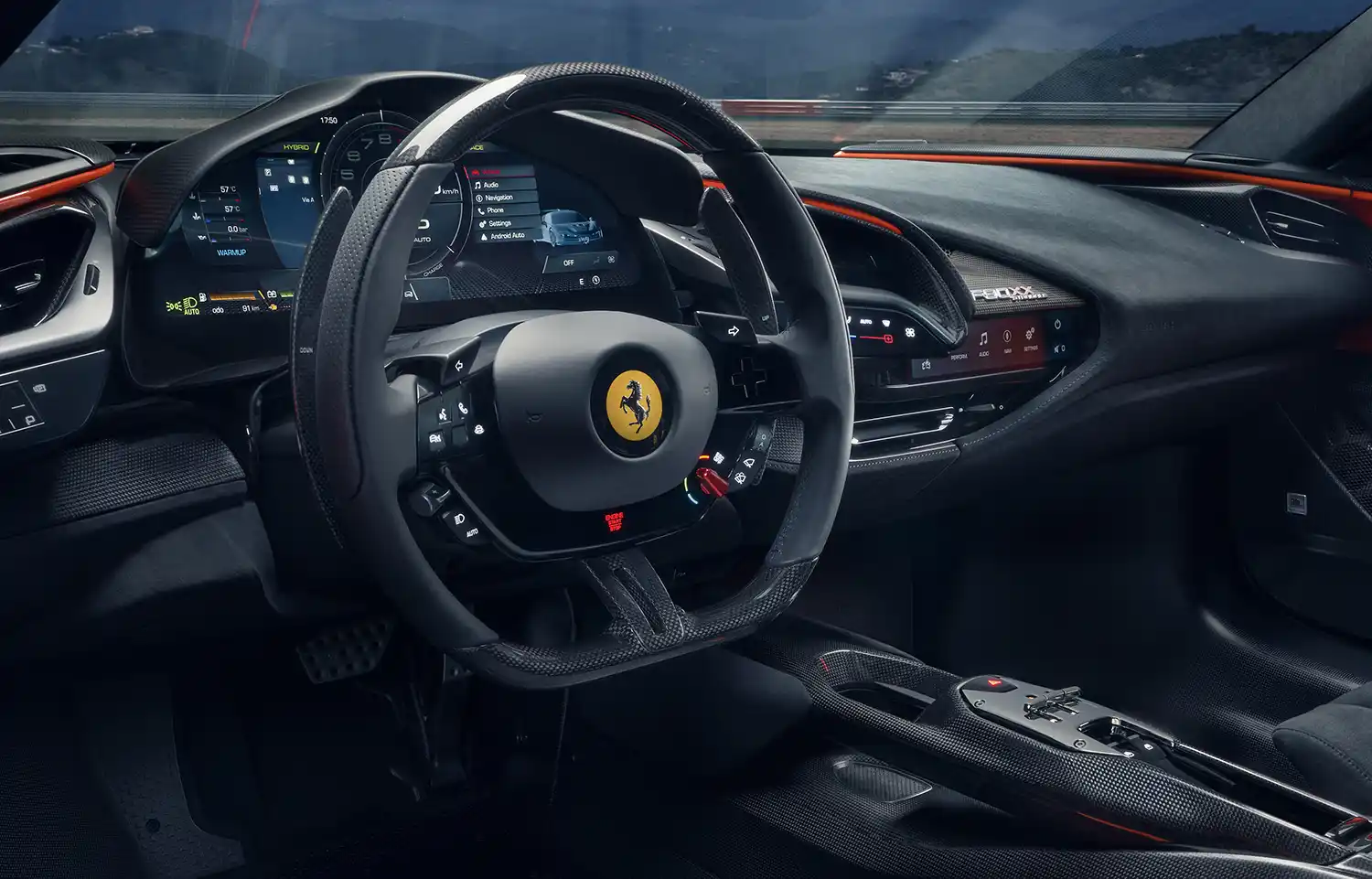
Consequently, the longitudinal force of the four tyres can be better exploited both in braking in a straight line and under braking during turn-in, where the rear axle has to deliver a natural trade-off between longitudinal braking performance and lateral stability. The system maximises the repeatability of the braking manoeuvre to a target value, reducing losses due to the tolerances of the components or the natural variability of test conditions. The controller thus allows the SF90 XX Stradale to brake later and in a more repeatable manner, thus enhancing its handling on the track.
The 6W-CDS sensor delivers much more data than the previous iteration: in particular, its ability to measure both the acceleration and the speed of rotation on three axes (X, Y, Z) enables the other vehicle dynamic controls to more accurately read the car’s dynamic behaviour, thus optimising their intervention with much greater precision.
In addition to this, also debuting on SF90 XX Stradale is the extra boost control logic which guarantees additional power in short bursts. The job of this software, which is only active in the Qualifying mode of the eManettino, is to produce an extra boost of power at the critical moment when the car is exiting a bend, something which alone improves lap time by 0.25s at Fiorano. The logic controls the power delivery, managing peak performance with battery charge, also monitoring the status of the components with the aim of optimising electric power delivery.
The availability of the extra boost is indicated by a graph on the right-hand side of the dash display, and shows the remaining number of bursts left (maximum 30). The control logic guarantees this feature is fully useable for at least one or more laps of the track depending on the latter’s individual characteristics. This is thanks to the fact that the areas of the track where activating the power surplus is most useful are pinpointed heuristically, attempting to exclude areas where using it would not reduce the lap time.
The car has a set-up with elastic characteristics and kinematic angles designed solely to optimise its behaviour on the limit. There is a 9% improvement in lateral performance (Ay max) compared to the SF90 Stradale in high speed handling conditions, mostly as a result of downforce. Furthermore, the roll rate was reduced by 10% thereby guaranteeing better body control.
Because the new car delivers significantly more downforce than the SF90 Stradale and consequently more rapid deceleration, the SF90 XX Stradale’s braking system was also upgraded. While it retains the Aero callipers at the front, the front discs have been completely redesigned to improve cooling, there are now bigger 390mm-diameter rear discs and the brake pads are a new design that maximise the contact surface to improve the coefficient of friction.
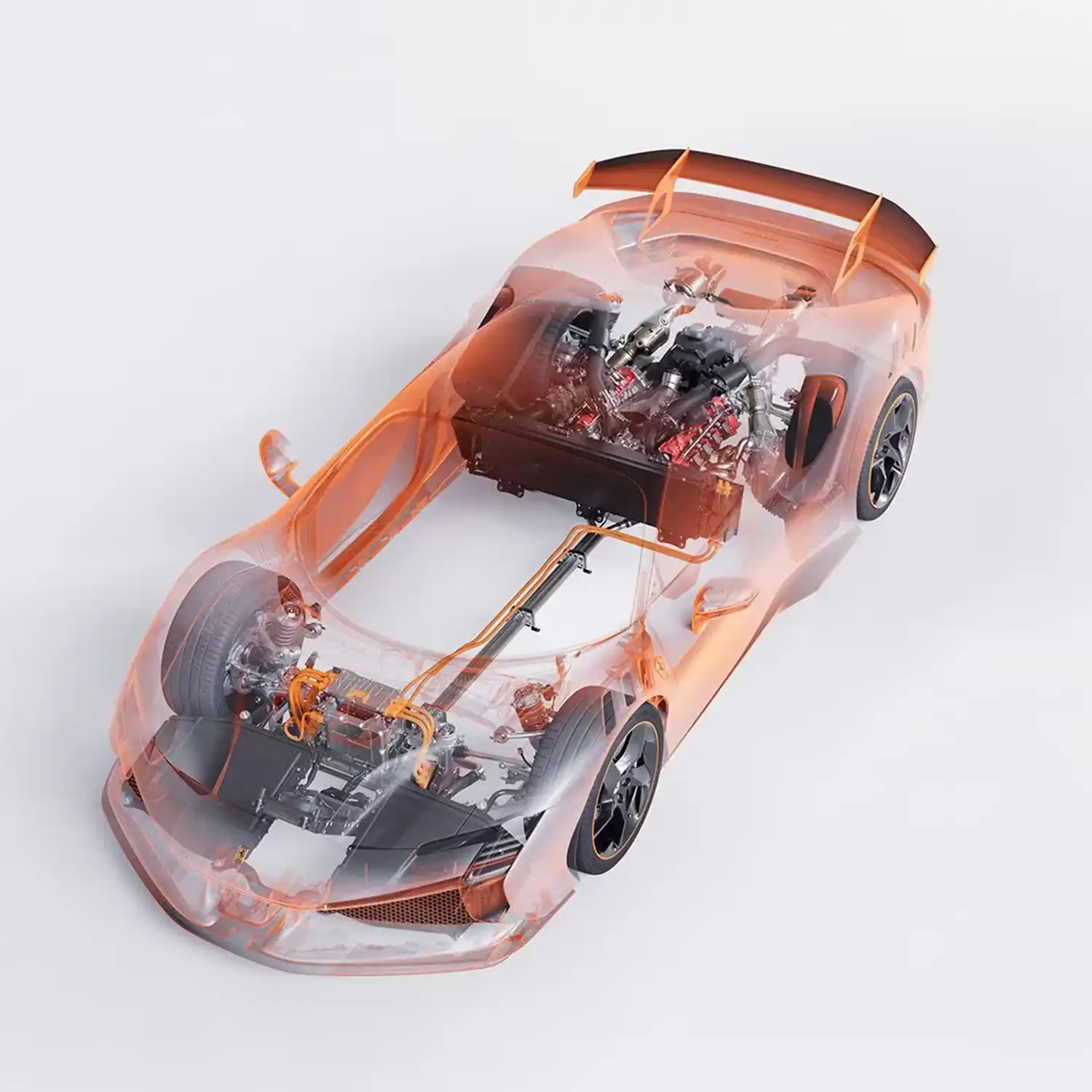
STYLING
EXTERIOR
The SF90 XX Stradale is the most extreme version of the SF90 Stradale; its design criteria are thus those of a track car, calibrated to ensure it can be homologated for road use. That said, the SF90 XX Stradale is not just a special version: it is the first XX model to go through the factory gates, transferring the very pinnacle of Prancing Horse track technology, aerodynamic efficiency and power, to the road.
Designed by the Ferrari Styling Centre headed by Flavio Manzoni, the SF90 XX Stradale incorporates the engineering principles that underpinned the SF90 Stradale and pushes them to new extremes. Thanks to the close synergic relationship between the Styling Centre and the Technical Department, significant modifications were carried out, predominantly with the aim of increasing the downforce of the original car.
In terms of its concept, this is to all intents and purposes an XX car. Its characteristics, the fruit of a more incisive, radical design language, are even more extreme still. The SF90 XX Stradale’s styling cues are designed to highlight its thoroughbred performance characteristics whilst still retaining the pure lines and forms of its predecessor. Hence the decision not to hide air intakes and vents, a fundamental part of racing cars’ stylistic language. A technical solution that also becomes a signature element: the three louvres on the SF90 XX Stradale’s front wing and on the rear one are an example of this. As was the case with the F12tdf, these are typical cues from Ferrari’s styling language.
There is no doubt that one of the most distinctive characteristics of the SF90 XX Stradale’s design is its rear wing. The tail volume, which has been specifically redesigned with aero in mind, is now sleeker, giving it the long tail silhouette typical of racing cars. The air intakes for the intercoolers are now larger too, channelling the air towards the radiators more efficiently.
The arrow-shape front wing concept has been retained on the SF90 XX Stradale. The headlights, which now have an even lower upper profile, are now integrated into this area by two external vertical wing profiles. This creates what we might call a more geometric language that reflects the spirit of this new car. New and distinctive elements of the front section are the two imposing lower wings that dominate the air intakes, which look as if they are floating, making the SF90 XX Stradale itself seem broader and more glued to the asphalt than any other.
The rear of the car is characterised by the trimaran design of the tail. Compared to the SF90 Stradale, the SF90 XX Stradale features more imposing rear vents behind the wheels. The trimaran section also incorporates two central exhausts. Design-wise, the aim here was to visually underscore the impressive width of the rear of the car and this was achieved by drawing on a layering concept.
One of the layers is the fixed rear wing, a solution not seen on a street legal Ferrari since the 1995 F50. The second is the body-coloured profile that wraps around a light-bar, an element that is a complete departure from the twin-taillight concept of the SF90 Stradale. The third layer, already seen on the SF90, is the blown spoiler combined with an active aero concept known as a shut-off Gurney.
Carbon-fibre elements stand out from bodywork colour elements all over the car, but most especially in its lower section, to underscore the car’s technical aspects. Other connotative elements are the air vents in the shape of rounded-off quadrangles on both the front bonnet and rear engine lid, which effectively become a part of the car’s livery. They are designed as touches of colour that coordinate with the end plates on the carbon-fibre rear wing, for instance. The car also sports specific star-burst wheel rims with prominent aerodynamic profiles.
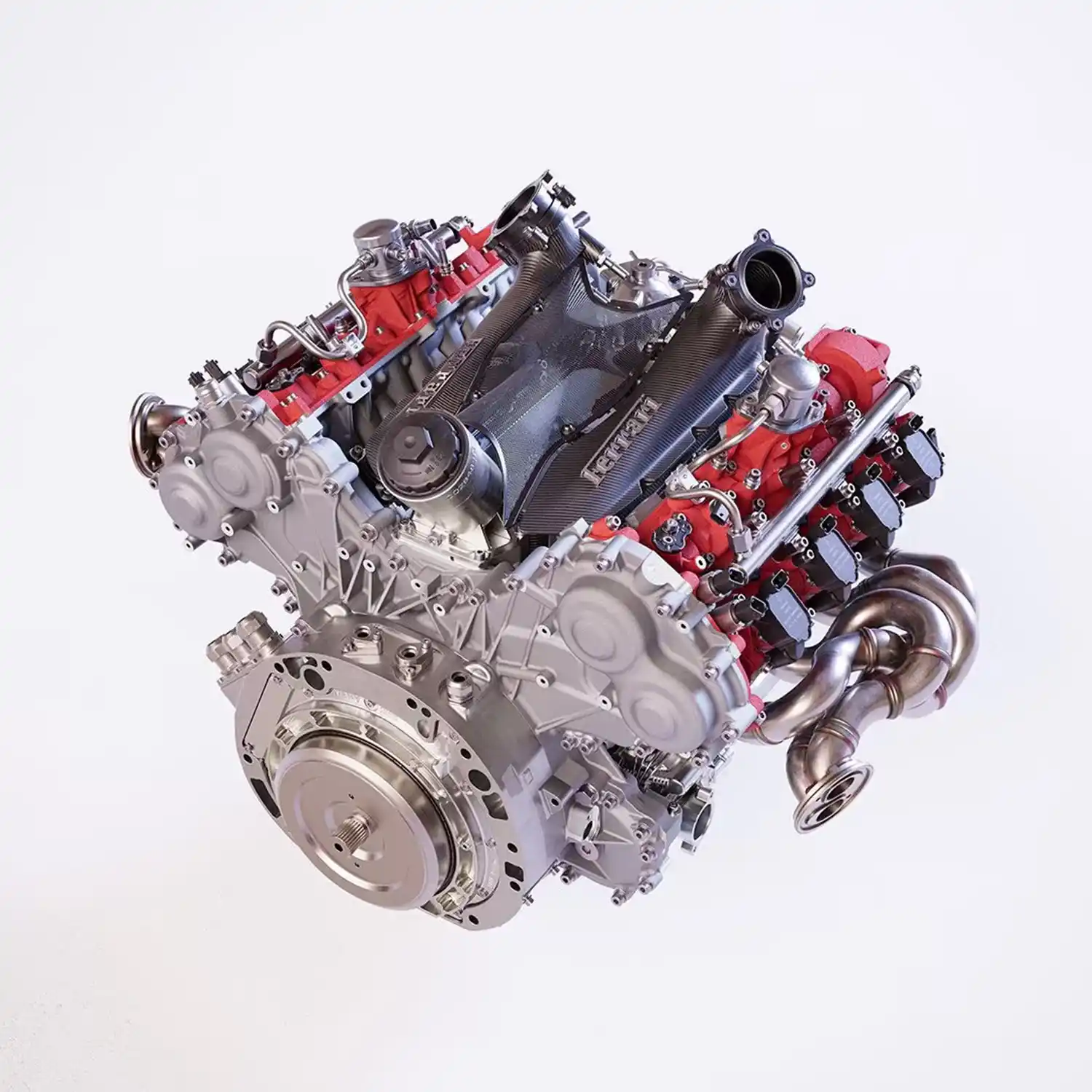
INTERIOR
The guiding principle of the SF90 XX Stradale’s interior design was highlighting the cockpit’s racing vocation through solutions that would provide significant weight-savings. The main areas involved were the door panels, tunnel and mats, which are now simpler in terms of their shape and the mainly technical fabrics used, while carbon-fibre was used for functional areas. The upper part of the dashboard is trimmed in Alcantara®, while the lower part is trimmed in technical fabric. Both are inspired by the racing world.
The door panels emphasise the theme seen aboard the SF90 Stradale: the concave sections that converge on the dashboard are highlighted by the colour contrast. The three louvres in the middle zone, on the other hand are a nod to the air vents on the wheel arch, creating an overall dynamic, sculptural effect. The three apertures, which reference the exterior language, also seamlessly integrate technical and control functions, in a completely new stylistic interpretation.
The pared-back central tunnel not only looks, but is exceptionally light. It is dominated by the gear shift gate which is located now centrally and more forward on the tunnel compared to the SF90 Stradale. The window lifters and the key compartment are on a secondary level. The styling theme is characterised by volumes that create a sophisticated combination of functional voids and structural solids, lending the tunnel a sporty yet sophisticated appeal while still highlighting its functionality.
A specific racing seat with a visible carbon-fibre tubular structure and cushion supports was designed for the car to enhance sporty driving pleasure without compromising on comfort. The backrest rake mechanism has been integrated into the seat using elastic trim materials which hide the separation between the backrest and seat squab. This means that the structure looks seamless at all times – just like a single-piece seat while also allowing the backrest to be adjusted. Together with the carbon-fibre structure, this feature saved 1.3 kg in weight compared to the SF90 Stradale’s single-piece seat.
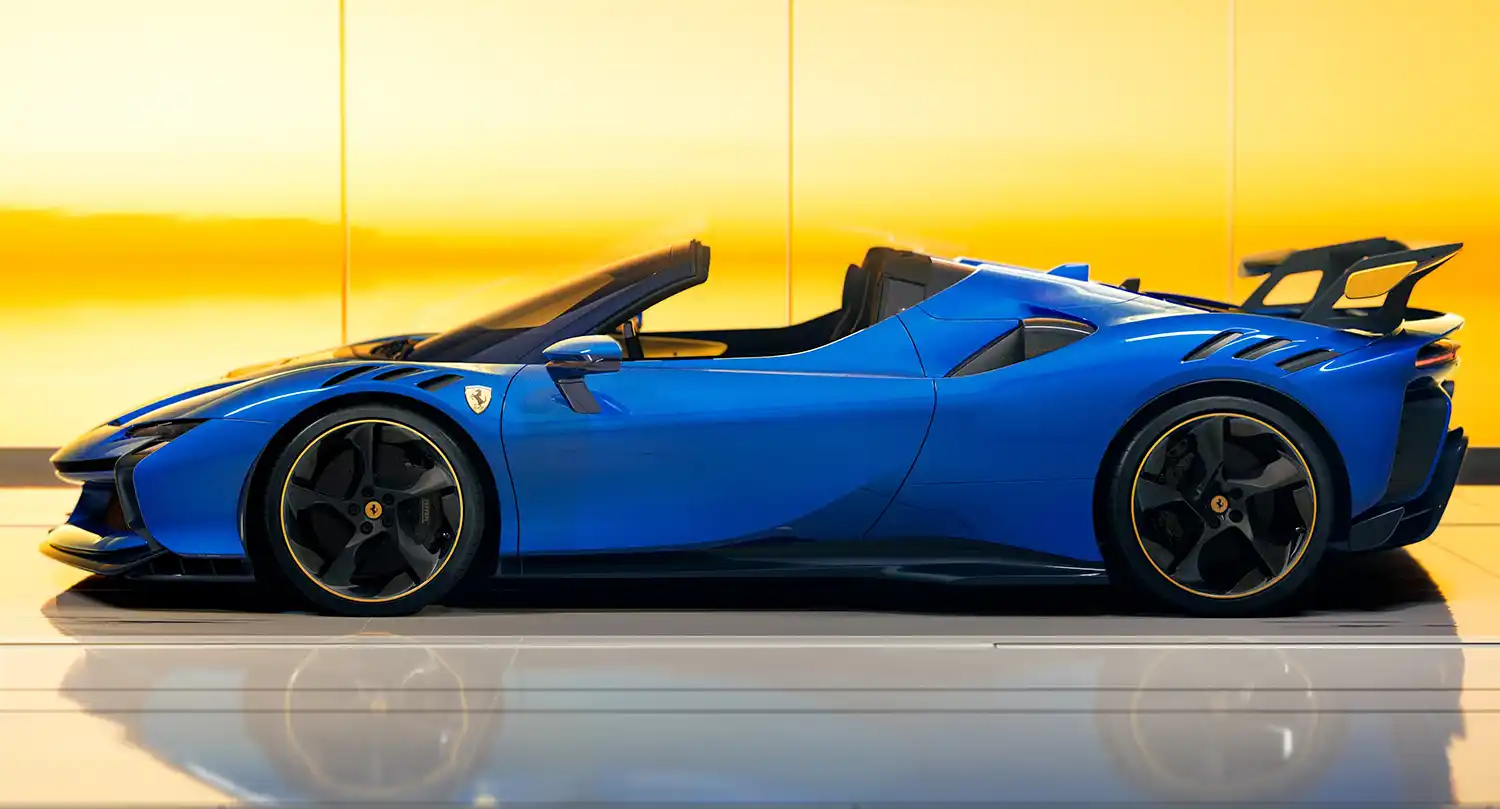
SF90 XX Spider
The SF90 XX Spider allowed the Ferrari Styling Centre to use the modifications made to the rear of the car to create an instantly recognisable architecture in which the flying buttress, a much-loved part of Ferrari tradition, seamlessly melds with the arrow theme of the front. The resulting visual effect extends the body forwards and lending it a completely different connotation to the SF90 XX Stradale.
The car’s centre of gravity thus appears to be lower too, particularly from the side. This is not just because of the roof, which has a wraparound windscreen that seamlessly melds with the side windows, but also because the flying buttresses are lower than on the SF90 XX Stradale. Although the roll-bars protrude from the rest of the bodywork when the roof is lowered, the fact that they are carbon-fibre means they don’t sully the broad, squat look created by the flying buttresses. This in turn enhances the visual lowering of the car’s volume.
When the roof is up, the roll-bars seamlessly connect to and become one with the roof structure. Like the roll-bars, the top is carbon-fibre and thanks to the renowned Ferrari Retractable Hard Top (RHT) mechanism, can be opened while the car is moving in a mere 14 seconds at a speed of up to 45 km/h, allowing occupants to enjoy the car to the utmost in all kinds of weather.
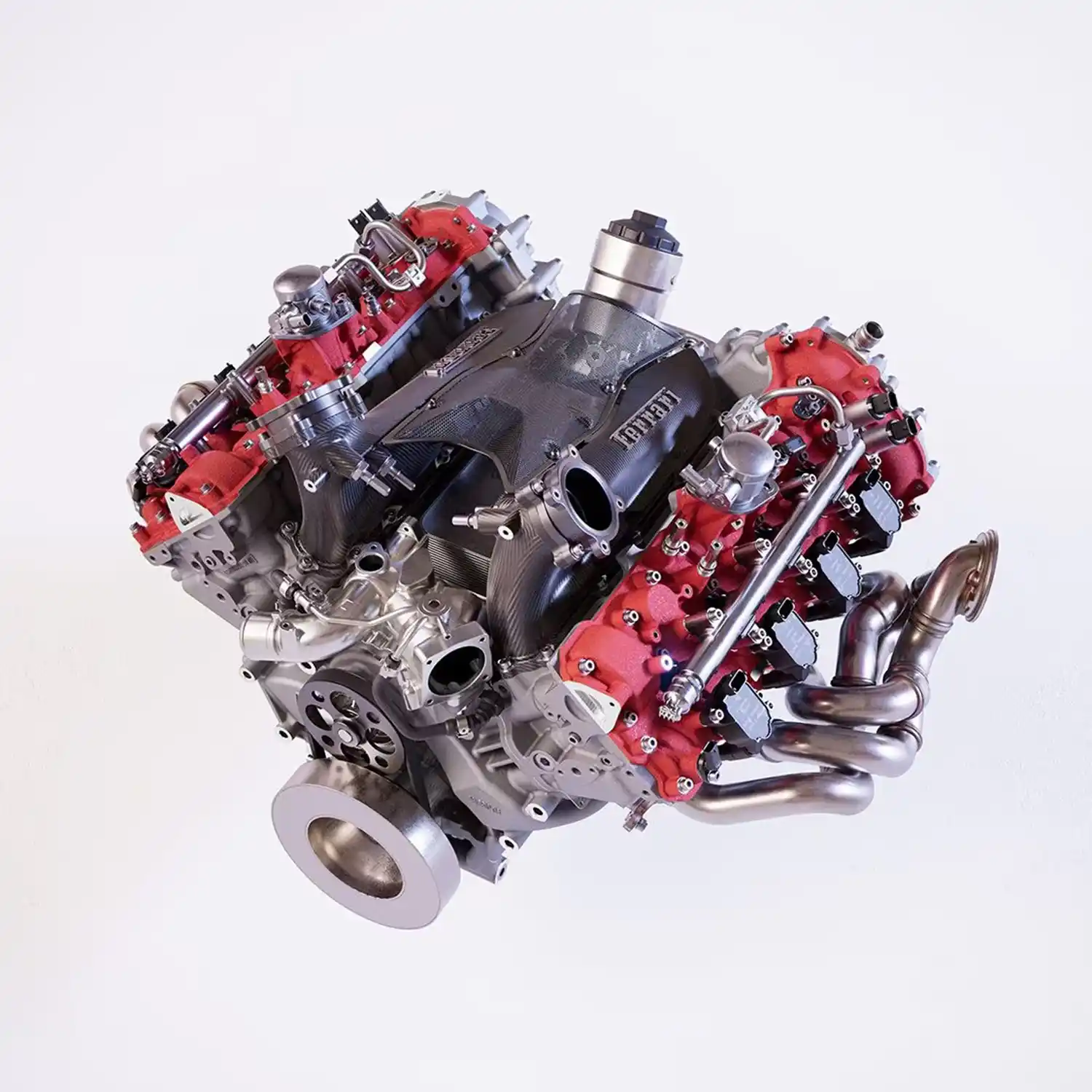
7 YEARS MAINTENANCE
Ferrari’s unparalleled quality standards and strong focus on client service underpin the extended seven-year maintenance programme offered with both the SF90 XX Stradale and the SF90 XX Spider. Available across the entire range, all regular maintenance for the first seven years of the car’s life is covered. This scheduled maintenance programme for Ferraris is an exclusive service that allows clients the certainty that their car is being kept at peak performance and safety over the years. This very special service is also available to owners of pre-owned Ferraris.
Regular maintenance (at intervals of either 20,000 km or once a year with no mileage restrictions), original spares and meticulous checks by staff trained directly at the Ferrari Training Centre in Maranello using the most modern diagnostic tools are just some of the main advantages of the Genuine Maintenance Programme. The service is available on all markets worldwide and from all Dealerships in the Official Dealership Network.
The Genuine Maintenance programme further extends the wide range of after-sales services offered by Ferrari to meet the needs of clients wishing to preserve the performance and excellence that are the signatures of all cars built in Maranello.
SF90 XX Stradale* – TECHNICAL SPECIFICATION
- POWERTRAIN
- Type V8 – 90° – twin turbo
- Overall displacement 3990 cc
- Bore and stroke 88 mm x 82 mm
- Max. power output* 586 kW (797 cv) at 7900 rpm
- Max. torque 804 Nm at 6250 rpm
- Max. revs** 8000 rpm
- Compression ratio 9.54:1
- Specific power output 200 cv/l
- Hybrid system
- Maximum power electric motors 171 kW (233 cv)
- Battery capacity 7.9 kWh
- Max. range under electric power 25 km
- DIMENSIONS AND WEIGHT
- Length 4850 mm
- Width 2014 mm
- Height 1225 mm
- Wheelbase 2650 mm
- Front track 1683 mm
- Rear track 1674 mm
- Dry weight*** 1560 kg
- Dry weight/power ratio 1.51 kg/cv
- Weight distribution 44% front / 56% rear
- Fuel tank capacity 68 litres
- TYRES AND WHEELS
- Front 255/35 ZR F20
- Rear 315/30 ZR F20
- BRAKES
- Front CCM 398 x 223 x 38 mm
- Rear CCM 390x 263 x 32 mm
- TRANSMISSION AND GEARBOX
- 8-speed F1 DCT
- ELECTRONIC CONTROLS
- eSSC (electronic Side Slip Control) 1.0; E4WD; SCM; FDE 2.0; EPS; ABS EVO
- PERFORMANCE
- Max. speed 320 km/h
- 0-100 km/h 2.3 s
- 0-200 km/h 6.5 s
- Fiorano lap time**** n.d.
- FUEL CONSUMPTION AND CO2 EMISSIONS
- Under homologation
- * Engine power is expressed in kW, in accordance with the International System of Units (SI) and in CV. With 98 octane-rated petrol and 5 cv of dynamic ram effect
- ** Max. overshoot: 8300 rpm
- *** With optional content
- **** Fiorano lap time will be set during the International Media Test Drive (IMTD) later this year
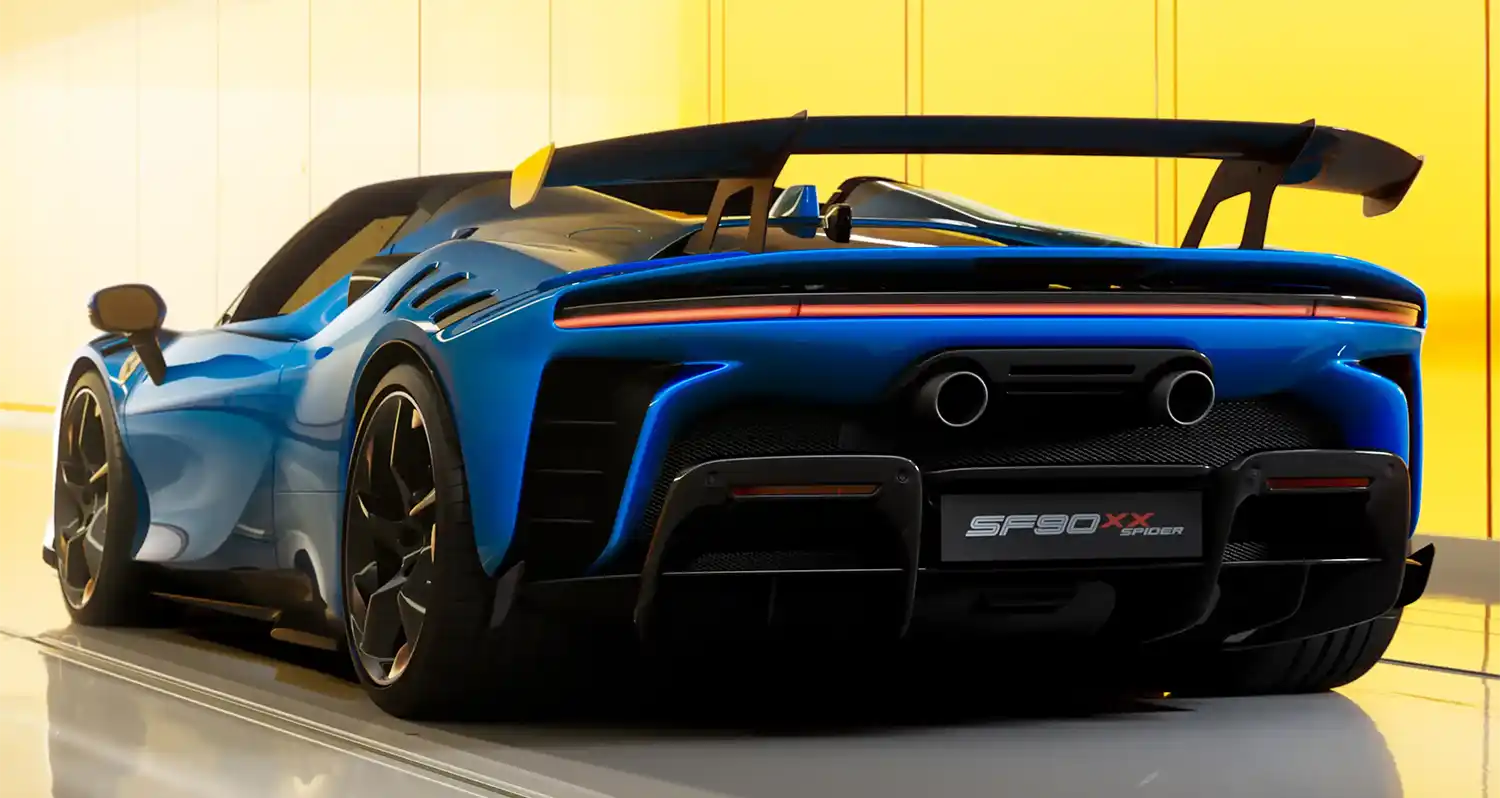
The post Ferrari SF90 XX (2024) appeared first on Wheelz.me-English.




